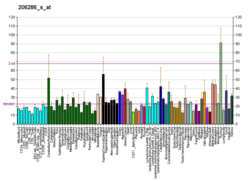Teratocarcinoma-derived growth factor 1
Teratocarcinoma-derived growth factor 1 is a protein that in humans is encoded by the TDGF1 gene.[5][6] The protein is an extracellular, membrane-bound signaling protein that plays an essential role in embryonic development and tumor growth. Mutations in this gene are associated with forebrain defects. Pseudogenes of this gene are found on chromosomes 2, 3, 6, 8, 19 and X. Alternate splicing results in multiple transcript variants.[7]
References
- 1 2 3 GRCh38: Ensembl release 89: ENSG00000241186 - Ensembl, May 2017
- 1 2 3 GRCm38: Ensembl release 89: ENSMUSG00000032494 - Ensembl, May 2017
- ↑ "Human PubMed Reference:".
- ↑ "Mouse PubMed Reference:".
- ↑ Dono R, Montuori N, Rocchi M, De Ponti-Zilli L, Ciccodicola A, Persico MG (Oct 1991). "Isolation and characterization of the CRIPTO autosomal gene and its X-linked related sequence". Am J Hum Genet. 49 (3): 555–65. PMC 1683146
 . PMID 1882841.
. PMID 1882841. - ↑ Scognamiglio B, Baldassarre G, Cassano C, Tucci M, Montuori N, Dono R, Lembo G, Barra A, Lago CT, Viglietto G, Rocchi M, Persico MG (Jul 1999). "Assignment of human teratocarcinoma derived growth factor (TDGF) sequences to chromosomes 2q37, 3q22, 6p25 and 19q13.1". Cytogenet Cell Genet. 84 (3-4): 220–4. PMID 10393436. doi:10.1159/000015263.
- ↑ "Entrez Gene: TDGF1 teratocarcinoma-derived growth factor 1".
Further reading
- Salomon DS, Bianco C, De Santis M (1999). "Cripto: a novel epidermal growth factor (EGF)-related peptide in mammary gland development and neoplasia.". BioEssays. 21 (1): 61–70. PMID 10070255. doi:10.1002/(SICI)1521-1878(199901)21:1<61::AID-BIES8>3.0.CO;2-H.
- Adamson ED, Minchiotti G, Salomon DS (2002). "Cripto: a tumor growth factor and more.". J. Cell. Physiol. 190 (3): 267–78. PMID 11857442. doi:10.1002/jcp.10072.
- Ciccodicola A, Dono R, Obici S, et al. (1989). "Molecular characterization of a gene of the 'EGF family' expressed in undifferentiated human NTERA2 teratocarcinoma cells.". EMBO J. 8 (7): 1987–91. PMC 401069
 . PMID 2792079.
. PMID 2792079. - Saccone S, Rapisarda A, Motta S, et al. (1995). "Regional localization of the human EGF-like growth factor CRIPTO gene (TDGF-1) to chromosome 3p21.". Hum. Genet. 95 (2): 229–30. PMID 7860072. doi:10.1007/BF00209409.
- Brandt R, Normanno N, Gullick WJ, et al. (1994). "Identification and biological characterization of an epidermal growth factor-related protein: cripto-1.". J. Biol. Chem. 269 (25): 17320–8. PMID 8006041.
- Friess H, Yamanaka Y, Büchler M, et al. (1994). "Cripto, a member of the epidermal growth factor family, is over-expressed in human pancreatic cancer and chronic pancreatitis.". Int. J. Cancer. 56 (5): 668–74. PMID 8314343. doi:10.1002/ijc.2910560511.
- Panico L, D'Antonio A, Salvatore G, et al. (1996). "Differential immunohistochemical detection of transforming growth factor alpha, amphiregulin and CRIPTO in human normal and malignant breast tissues.". Int. J. Cancer. 65 (1): 51–6. PMID 8543395. doi:10.1002/(SICI)1097-0215(19960103)65:1<51::AID-IJC9>3.0.CO;2-0.
- Kannan S, De Santis M, Lohmeyer M, et al. (1997). "Cripto enhances the tyrosine phosphorylation of Shc and activates mitogen-activated protein kinase (MAPK) in mammary epithelial cells.". J. Biol. Chem. 272 (6): 3330–5. PMID 9013573. doi:10.1074/jbc.272.6.3330.
- Xu C, Liguori G, Adamson ED, Persico MG (1998). "Specific arrest of cardiogenesis in cultured embryonic stem cells lacking Cripto-1.". Dev. Biol. 196 (2): 237–47. PMID 9576836. doi:10.1006/dbio.1998.8862.
- Xu C, Liguori G, Persico MG, Adamson ED (1999). "Abrogation of the Cripto gene in mouse leads to failure of postgastrulation morphogenesis and lack of differentiation of cardiomyocytes.". Development. 126 (3): 483–94. PMID 9876177.
- Ebert AD, Wechselberger C, Frank S, et al. (1999). "Cripto-1 induces phosphatidylinositol 3'-kinase-dependent phosphorylation of AKT and glycogen synthase kinase 3beta in human cervical carcinoma cells.". Cancer Res. 59 (18): 4502–5. PMID 10493495.
- Reissmann E, Jörnvall H, Blokzijl A, et al. (2001). "The orphan receptor ALK7 and the Activin receptor ALK4 mediate signaling by Nodal proteins during vertebrate development.". Genes Dev. 15 (15): 2010–22. PMC 312747
 . PMID 11485994. doi:10.1101/gad.201801.
. PMID 11485994. doi:10.1101/gad.201801. - Bianco C, Adkins HB, Wechselberger C, et al. (2002). "Cripto-1 activates nodal- and ALK4-dependent and -independent signaling pathways in mammary epithelial Cells.". Mol. Cell. Biol. 22 (8): 2586–97. PMC 133714
 . PMID 11909953. doi:10.1128/MCB.22.8.2586-2597.2002.
. PMID 11909953. doi:10.1128/MCB.22.8.2586-2597.2002. - Yan YT, Liu JJ, Luo Y, et al. (2002). "Dual roles of Cripto as a ligand and coreceptor in the nodal signaling pathway.". Mol. Cell. Biol. 22 (13): 4439–49. PMC 133918
 . PMID 12052855. doi:10.1128/MCB.22.13.4439-4449.2002.
. PMID 12052855. doi:10.1128/MCB.22.13.4439-4449.2002. - de la Cruz JM, Bamford RN, Burdine RD, et al. (2002). "A loss-of-function mutation in the CFC domain of TDGF1 is associated with human forebrain defects.". Hum. Genet. 110 (5): 422–8. PMID 12073012. doi:10.1007/s00439-002-0709-3.
- Strausberg RL, Feingold EA, Grouse LH, et al. (2003). "Generation and initial analysis of more than 15,000 full-length human and mouse cDNA sequences.". Proc. Natl. Acad. Sci. U.S.A. 99 (26): 16899–903. PMC 139241
 . PMID 12477932. doi:10.1073/pnas.242603899.
. PMID 12477932. doi:10.1073/pnas.242603899.
This article is issued from
Wikipedia.
The text is licensed under Creative Commons - Attribution - Sharealike.
Additional terms may apply for the media files.




